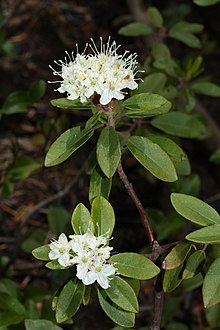Ledum
| Rhododendron subsect. Ledum | |
|---|---|
 |
|
| Rhododendron columbianum (Ledum glandulosum) | |
| Scientific classification | |
| Kingdom: | Plantae |
| (unranked): | Angiosperms |
| (unranked): | Eudicots |
| (unranked): | Asterids |
| Order: | Ericales |
| Family: | Ericaceae |
| Genus: | Rhododendron |
| Subgenus: | Rhododendron |
| Section: | Rhododendron |
| Subsection: |
Ledum (L.) Kron & Judd |
| Species | |
|
See text. |
|
See text.
Ledum was a genus in the family Ericaceae, including 8 species of evergreen shrubs native to cool temperate and subarctic regions of the Northern Hemisphere and commonly known as Labrador tea. It is now recognised as a subsection of section Rhododendron, subgenus Rhododendron, of the genus Rhododendron.
Recent genetic evidence has shown that the species previously treated in this genus are correctly placed in the genus Rhododendron, where they are now treated as Rhododendron subsect. Ledum.
Because some of the species names used in Ledum could not be used in Rhododendron (the names already having been used for other species already in this large genus), new names had to be coined for them.
The species formerly listed in Ledum, with their current accepted names in Rhododendron, are:
One natural hybrid also occurs:
Some species (e.g. L. groenlandicum) have been used to produce Labrador tea. Other species have varying levels of toxicity (e.g. L. glandulosum). Evergreen Labrador Tea grows slowly, but retains its leaves year-round. Users should take care not to over-harvest leaves from any single plant.
Ledum spp. often grow together with poisonous plants such as bog-laurel and bog-rosemary, but certain species (e.g. L. groenlandicum and L. palustre) are easily distinguished by the distinctive rust coloured fuzz on the bottom of leaves.
According to a Russian study from 1991,Ledum was able to almost completely inactivate the tick-borne bacterial infection caused by Borrelia, involved in the pathogenesis of Lyme disease.
...
Wikipedia
